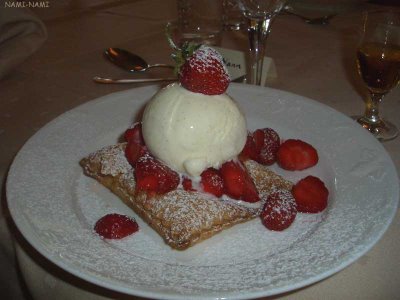
After forageing for
wild strawberries in Paluküla, we headed into the bog forest to look for
cloudberries. Cloudberries are definitely one of my favourite berries - another berry
strongly reminiscent of my childhood, and last August I breakfasted on delicious
cloudberry & cream cheese yogurts, and I regularly stock up on cloudberry jam at my local IKEA store. Even if you're unfamiliar with the berry, you have probably heard of it.
Tessa Kiros, the queen of nostalgic and sultry cookbooks, has a beautiful book called
Falling Cloudberries
- though I was somewhat puzzled by her choice of title - the cover image depicts cranberry sorbet and there isn't a single cloudberry recipe inside, just a brief mention on p. 69.
Cloudberry (
Rubus chamaemorus) is a member of the rose family. It is also known as baked-apple berry, especially in Canada, although I'm not sure about this name - I can't see the similarity between baked apple - another great yogurt flavour! - and cloudberries; it is one of the species of salmonberries (probably called so for its colour and not for its taste!). They're related to raspberries, but taste anything but, being much more exquisite in flavour, with a slight hint of honey. Cloudberries grow on mossy and boggy land in the cold northern climates of Scandinavia (apparently very abundant in the bogs of Lapland, though I cannot confirm this myself. Yet.),

Finland (where it even decorates the back of the 2 EURO coin), Estonia and other Baltic countries, Siberia and Canada, as well as near the Arctic Circle. As there is just one berry per plant and the growing area is very limited, they are rather costly. Certainly, cloudberry jam in IKEA costs thrice as much as other jams! Indeed, cloudberries are so costly that they can trigger wars among the usually calm Scandinavians: cloudberries are
"
so valued in northern Scandinavia where Finland, Sweden, and Norway meet; the cloudberry has long been the cause of "cloudberry wars". These otherwise peace-loving countries have been known to become quite territorial when it comes time to harvest this berry, causing the Swedish Ministry for Foreign Affairs to develop a special section just for cloudberry diplomacy."
(
Alan Davidson. 1999. The Oxford Companion to Food. Oxford: Oxford University Press)

Just like looking for wild strawberries requires a good and attentive eye, forageing for cloudberries needs patience and a sharp vision. Here's what you do. You arrive at your secret cloudberry spot and look around. Carefully. Look at the various green-yellow bumps of grass on the ground, trying to spot a golden-pink berry amongst the dark leaves. Voilà! After spotting a berry, you go, bend your knees and pick it up, twisting the berry off its stalk. Stand up. Repeat. Very good exercise, both for the body and the mind!
As it's been a particularly dry and hot summer in Estonia this year, with temperatures reaching mid 30s Celsius, the bog was rather dry. This wasn't all bad, as it meant I could look for cloudberries without getting my toes wet. But it also meant that cloudberries were rare, and the ones that did exist, tended to be on the small side.

This was one of the few cloudberries in the bog that was ready for eating then and there. A ripe cloudberry is orange-yellow in colour, and very juicy. Pop these straight into your mouth.

This is another close-up of the cloudberry. Pretty, isn't it? This one is slightly underripe though (hence the reddish hue). You would have to leave it at room temperature for a few days to ripen. However, it is in the perfect stage for jam-making.
Again, between three of us we managed to collect a small glass of cloudberries, so no jam-making followed. Instead, we ate the ripe ones then and there, and left the rest on the kitchen table to ripen for a few days.
I had couple of my girlfriends over for a drink and some nibbles on my new balcony at my parents' house few days before my trip to the strawberry fields and cloudberry bogs. One of the canapes I served was inspired by
this recipe from the Swedish
Arla website. Very Nordic, slightly unusual and oh-so-tasty. Even the only man in the company (Siim Oskar, aged 10 months) had a few.
Rye bread canapés with blue cheese and cloudberry jam
(
Sinihallitusjuustu-murakaamps)

cloudberry jam (I used
Meie Mari murakamoos, but IKEA sells a decent one)
blue cheese (I used Dolcelatte)
crisp bread or rye bread
Cut the rye bread into small squares (4x4 cm), or break into similarly-sized pieces, if using crisp bread.
Spread with blue cheese and top with a small spoonful of cloudberry jam.
Garnish with small basil leaves or blue borage flowers (above).
























